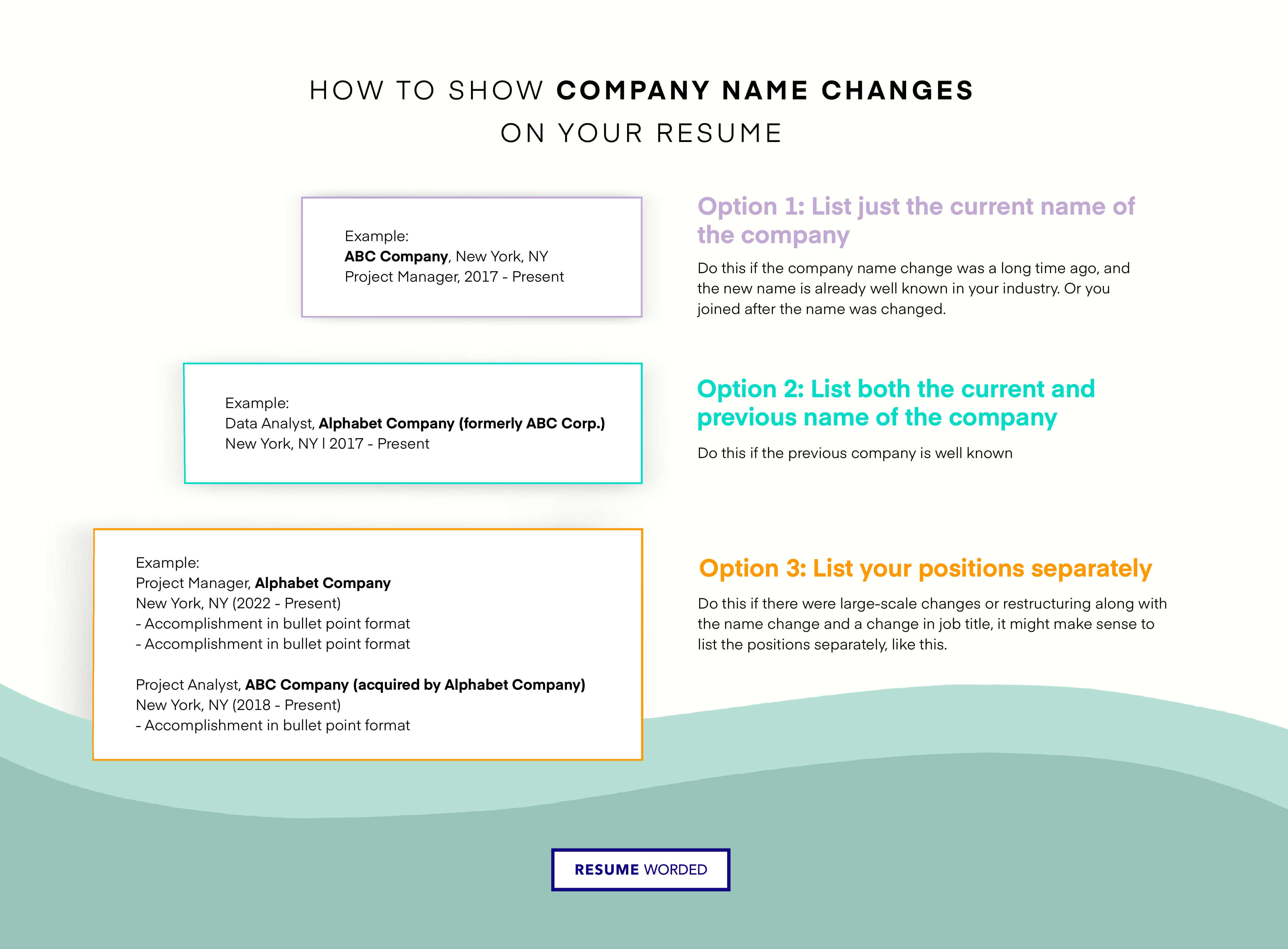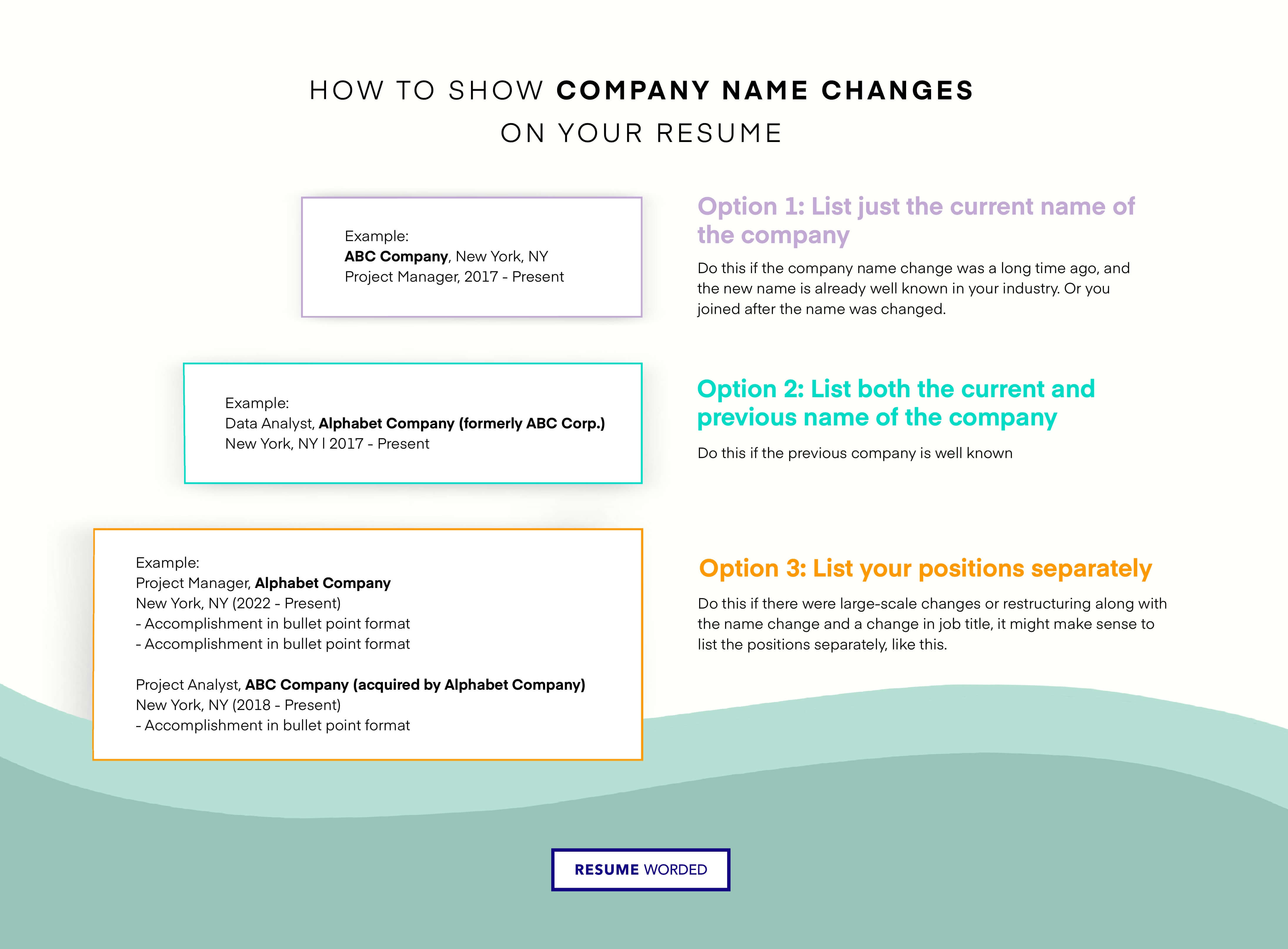What’s in a name? Quite a bit, actually.
Company name changes aren’t at all uncommon — but that doesn’t mean they don’t need to be addressed. While you might know instinctively that the company you listed as Company A on your resume is now Company B, most recruiters aren’t going to have the same background. So, whether it was due to a merger, acquisition, or large-scale rebranding, here’s how to tackle a company name change on your resume.
How to list a company name change on a resume
There are four main ways of listing a company name change on your resume:
- List only the current name of the company
- List the current name of the company followed by the previous name
- List the previous name first followed by the current name
- List your positions separately under each company name

There are a few optimal ways of labeling a company name change on your resume, depending on your specific circumstances. If you worked at a company formerly known as the Alphabet Company that now goes by ABC Company, here are some practical examples of how to list that on your resume.
Option #1: List only the current name of the company
Don’t want to make a big deal of it? In pretty much all cases, you don’t have to. Simply list the company on your resume under its current name, like this:
Job Title, Current Company Name
Location + dates of employment
For example, here's how it could be added into an actual resume:
ABC Company, New York, NY
Project Manager, 2017 - Present
or, as an alternative:
Project Manager, ABC Company
New York, 2017 - Present
Option #2: List the current name of the company followed by the previous name
If you want to clarify the previous name of the company, simply add that in parentheses after its current name, like this:
Job Title, Current Company Name (formerly Previous Company Name)
Location + dates of employment
For example, here's how it might look on a resume:
or in text format:
ABC Company (formerly Alphabet Company), New York, NY
Project Manager, 2017 - Present
Option #3: List the previous name first followed by the current name
If you have a good reason for wanting to list the previous name of the company more prominently (like if it’s a recent change and the company is better known under its former name), you can list it like this:
Job Title, Previous Company Name (now Current Company Name)
Location + dates of employment
For example, here's what it looks like on a resume:
Option #4: List your positions separately under each company name
If there were large-scale changes or restructuring along with the name change, it might make sense to list the positions separately, like this:
Job Title, New/Current Company Name
Location + dates of employment
Job Title, Previous Company Name (acquired by New/Current Company)
Location + dates of employment
For example:
This is a good idea if you held a very different role when the company went through a restructuring or if you had to apply for the new role when you moved positions.
Use a resume checker
The best way to make sure your resume is formatted correctly, including any company name changes, is to upload it to the tool below — it’ll scan it, highlight any errors or inconsistencies and give you instant feedback on how to improve your resume.
Should you mention a previous company name on your resume?
It depends on your situation, but generally:
Listing just the current name of your company is fine, especially if you’ve only worked at the company under its current name or if you were otherwise unaffected by the name change. Hiring managers don’t need a detailed history of every company you’ve ever worked at, which means they‘re unlikely to care that your company once operated under a different name.
That said, there are some situations when it may be a good idea to list the previous name of a company on your resume.
If the previous company name was well-known
Sometimes, rebrandings don’t quite take. If the company name change was very recent, or if your company was much better known (or even instantly recognizable) under its previous name, it makes more sense to list it under that name on your resume.
If you worked for the company under a different name
If a company changed its name after (or while) you worked there, it might make sense to specify the company name as it was when you were there — especially if your references are also likely to know or refer to the company by its former name.
If you played a large role in the merger or acquisition
If you’re planning to reference the company name change elsewhere on your resume, make sure you list both names to avoid confusion. So if you played a big role in a merger, acquisition, or restructuring, or you want to highlight accomplishments related to the company name change, it makes sense to use a more descriptive company heading that includes the name change.
If there was a major restructure
If the company name change wasn’t just a superficial change, but also signified a major restructure, it can make more sense to list both company names on your resume.
If your role or title changed
This goes double if your role changed significantly under the changes, like if you were promoted or moved to a different position. Showing a progression of skills or responsibilities while there were big company changes or restructurings is a big plus to hiring managers — it shows a lot of adaptability.
On that note, you can search for skills to put on your resume below:
When to leave off a previous company name
There are also a few situations where you want to avoid mentioning the previous name of a company. You might choose to leave off the company's previous name if:
- The company name change was a long time ago, and the new name is already well known in your industry.
- You joined the company after the name change.
- The previous name has 'bad press' — i.e. they were in the news for the wrong reasons and you don't want to call attention to it (even if you did nothing wrong).
- The previous company name and new company name are equally known in your industry.
Dealing with mergers and acquisitions
How to show a merger
Hiring managers want to see if your role evolved or changed due to a company merger. If you adjusted well to a new role, it shows the ability to adjust to new situations, develop new skills and work with new team members.
How to show a company acquisition
If the company went through an acquisition, you may want to explicitly specify that — especially if your role was affected by it. You can do this with a quick note in parentheses beside the company name.
If your company acquired another, you don't need to list that in the company name section of your resume. You can, however, include bullet points relating to the acquisition if you played a major role in it, or if your role was impacted in a significant way.
How to list companies that don't exist, are defunct or are no longer in business
What if a company you once worked for is now defunct, closed down, or simply no longer exists? That doesn’t mean you need to scrub it from your resume! Much like a company name change, you can deal with this by simply listing the company name as it was when you worked there.
If the company shut down while you worked there
If you lost your job (or were laid off) because the company shut down, it makes sense to highlight that on your resume. This emphasizes to hiring managers that you weren't dismissed for performance-related reasons.
Let's look at a quick example if this is the case:
Senior Analyst, 2004-2008
Lehman Brothers (shut down in 2008), New York
If the company went out of business after you worked there
If you were unaffected by a company shutdown, you don't need to worry about it — you can simply list the company as normal on your resume. You don’t need to proactively offer that the company has now closed.
If you’re still worried about it, here are a few do’s and don’ts for your resume:
- Don’t go into too many details on your resume. Potential employers can easily verify the information on your resume via a reference check, business registration information, IRS, or even with a quick Google search.
- Do be prepared to provide additional evidence if necessary. This is unlikely to be a problem, but if issues arise with a background check, you can resolve them by providing old payslips or W-2 forms.
- Don’t use it as an opportunity to fudge the details of your employment, like changing your job title or lying about how long you worked there. These details can still be discovered, even if the company has now closed, and lying on your resume is instant cause for dismissing your application (and may be grounds for firing, if you lie and get the job anyway).
- Do answer any questions simply and directly. If you’re asked about it in a job interview, you can just say that the company has closed down since you worked there.
- Don’t worry that it will reflect badly on you. Hiring managers understand that companies go out of business and that it isn’t a reflection of your job performance.
Frequently asked questions
What is the difference between mergers and acquisitions?
The terms merger and acquisition are often used interchangeably, but there is a difference between the two. A merger happens when two companies join forces to become a separate, larger company. An acquisition — also known as a takeover or a buyout — is when one company buys another (usually smaller) company. In this case, the second company effectively ceases to exist and becomes part of the first company.
What are the potential consequences of a company name change?
You're unlikely to be affected by a company name change. At worst, it may make it more difficult for potential employers to verify your job history or contact references, but this is the sort of thing that happens all the time, and recruiters are used to dealing with it. If you're worried, keeping any records of your employment (like payslips or W-2 forms) should be enough to fix any issues that crop up.
Should I list the company name or job title first?
Choosing between listing your company name first or your job title is just a matter of what's more impressive. If you work for a big-name company that changed its name, list the company name first and then your job title.









